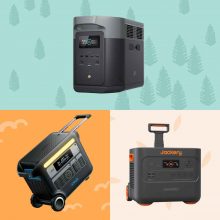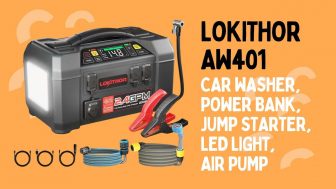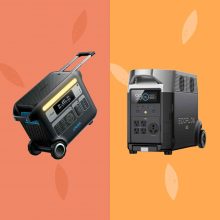- Factors to consider when choosing a portable power station
- Understanding battery type
- Additional Portable Power Station Features
- How to charge your portable power station
- What are the best portable power stations for home use?
- Using Your Portable Power Station – Tips and Tricks
- What are the key components of a portable power station?
- Portable Power Stations and Renewable Energy Resources
- FAQs
- Final Thoughts

With extreme weather events on the rise, it’s more likely than ever that your household will experience a power outage at some point. In fact, you may have already been in a situation where your entire street block was dark except for the one house that was savvy enough to invest in a portable power station.
For this reason, having backup power at home is essential. It’s an invaluable asset for emergency preparedness, and provides you with reliable power and the ability to keep vital systems, appliances, and even your electric vehicle running without relying on the grid.
In this blog post we’ll explain how to choose a portable power station for your home, including benefits, features, usage and tips that are important to know when shopping for a portable power station.
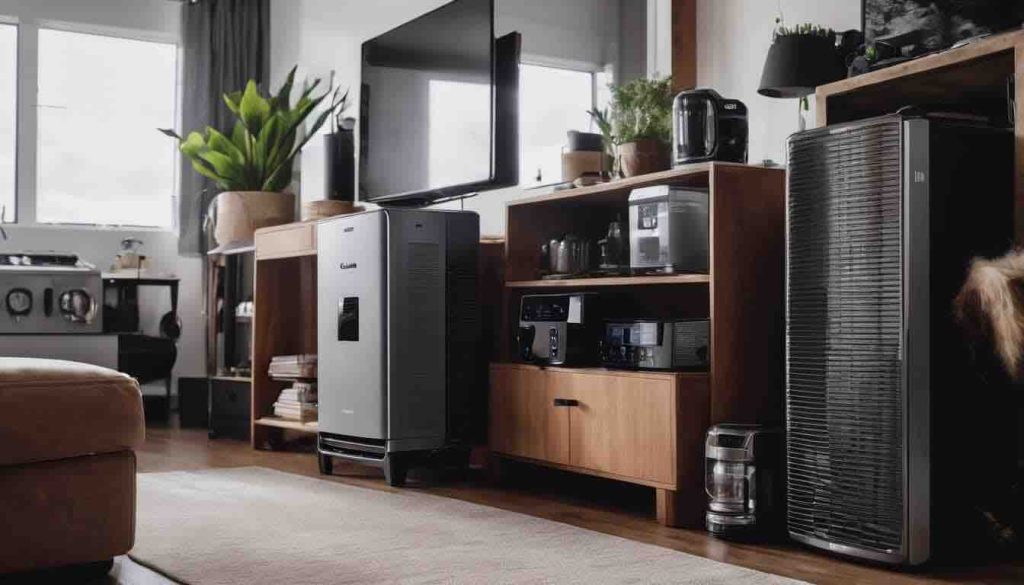
What is a portable power station?
A portable power station is an energy storage device that serves as a backup power supply during emergencies, power outages and off-grid activities.
Power stations offer emergency backup power to keep your home supplied with consistent electricity, as long as it has adequate battery capacity to cover you needs. Thus, when you buy a portable power station for your it’s important to choose the best model for your needs.
With features such as portability, renewable energy from the sun and convenient outlets for powering devices of all shapes and sizes, portable power stations also provide a reliable backup power source for camping, tailgating and DIY prepping.
How does a portable power station work?
A portable power station uses a re-chargeable battery to generate and store electricity. It works by storing the energy in the form of either DC or AC current from sources like solar panels, AC wall outlets, 12V car chargers and USB-C ports. This energy can then be used power an entire home, including essentials like a fridge, lights and AC when a regular electricity connection fails.
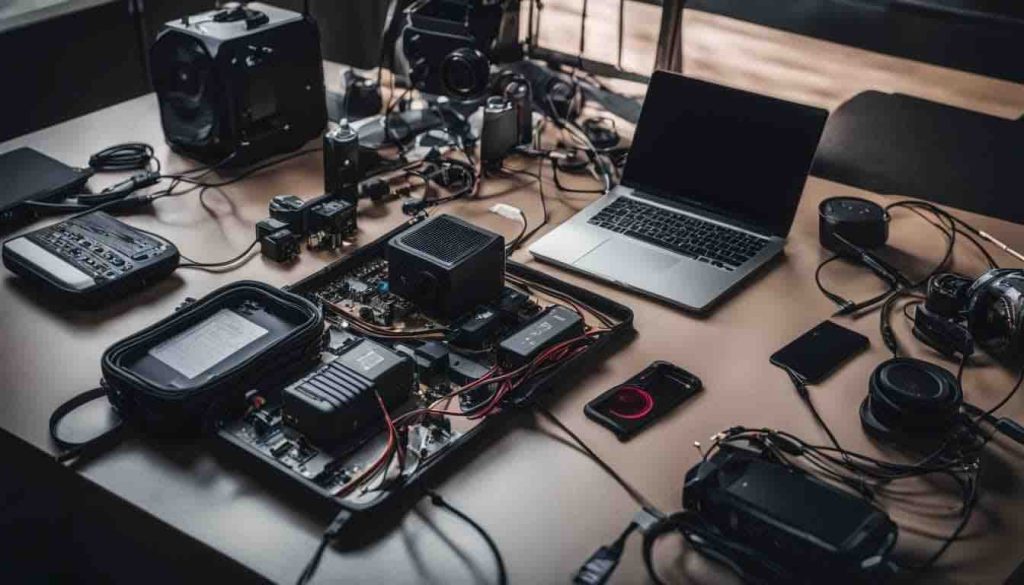
Factors to consider when choosing a portable power station
There are several key features that to consider choose the right power station for your needs. These factors will determine how well the device works in your home and how much value it provides for your money.
How to calculate your power consumption
In order to know how much capacity and output you need in your power station, you need to figure out approximately how much power you’ll consume during an outage. Here is a step-by-step guide on how to calculate your power needs:
- Identify your essential appliances and devices. Make a list of all the electronics that need continuous power during an outage, including appliances like refrigerators, medical devices, phones, cooling and heating systems, lights, etc.
- Find out the wattage (W) rating, or kWh/month usage for each device. Make sure to check if device wattage ratings are different when devices are on standby operation vs non-standby.
- Calculate total watts per hour (W/h) by multiplying each device’s wattage (W) rating by its run time (average number of hours used daily). This tells you how many watts per hour an individual device needs.
- Calculate total daily wattage consumed (W/day) by adding up all the watts per hour for each device and multiply it by 24 (total hours in one day). This tells you how many total watts per day that you need to run all of your devices.
How to determine capacity and output
Understanding power capacity and output is essential in order to know how much energy you need, so be sure to calculate these accurately before purchasing.
What is capacity?
Capacity is one of the most important features it tells you how much energy a power station can store, and how long you can use it before needing to recharge. Capacity is measured in “watt hours”, which tells you the maximum amount of wattage a power station can support per hour.
Keep in mind that home appliances typically use more watts per hour than small devices like a phone or tablet. Thus, you’ll need more capacity to power your home than you would in other situations, like camping.
How much capacity do you need?
Your power capacity needs to support your total daily wattage (W/day), or your total watts per hour (W/h) for an extended period of time. Think about how many devices and appliances you plan on running at the same time, which can use more energy than you expect.
Best practice is to get a battery with more capacity than what you need. Having too much energy is far better than having too little.
For example, if your calculated watts per day (W/d) is 2,000Wh, then you should get a power station with a minimum of 3,000Wh capacity.
If your watts per hour (W/h) is 300Wh, a 3,000Wh portable power station will run for about 9 to 10 hours before needing a recharge.
Estimated Operating Time by Device Wattage
Device Watts 200Wh 500Wh 1000Wh 3000Wh 25000Wh Mobile Phone 30 watts 6 charges 16 charges 33 charges 100 charges 833 charges Laptop 60 watts 3.33 hrs 8.33 hrs 16.67 hrs 50 hrs 416.67 hrs CPAP 100 watts 2 hrs 5 hrs 10 hrs 30 hrs 250 hrs Television (>40”, HD TV) 200 watts 1 hr 2.5 hrs 5 hrs 15 hrs 125 hrs Refrigerator 225 watts 0.89 hrs 2.22 hrs 4.44 hrs 13.33 hrs 111.11 hrs Space Heater 250 watts 0.8 hrs 2 hrs 4 hrs 12 hrs 100 hrs Washing Machine 350 watts 0.57 hrs 1.43 hrs 2.86 hrs 8.57 hrs 71.43 hrs Air Conditioner (5,000 BTU) 500 watts 0.4 hrs 1 hr 2 hrs 6 hrs 50 hrs Blender 800 watts 0.25 hrs 0.63 hrs 1.25 hrs 3.75 hrs 31.25 hrs Coffee Maker 1500 watts 0.13 hrs 0.33 hrs 0.67 hrs 2 hrs 16.67 hrs Microwave Oven 1800 watts 0.11 hrs 0.28 hrs 0.56 hrs 1.67 hrs 13.89 hrs
What is power output?
Each individual outlet and port on the power station has a maximum output level, which relates to the device’s wattage ratting. The device wattage should not exceed the power output that you plug into. For example, if an AC outlet has output of 300W, your device wattage rating should be less.
Many portable power stations are designed with peak surge output, which means that the output can temporarily exceed the baseline output. For example, if an outlet has out of 300W, with peak surge of 600W, you can plug in a device with higher wattage rating for a short amount of time.
You want to make sure you can safely plug as many devices as needed into the power station. Once again, since you may be running several large appliances at the same time, get a power station with enough output wattage.
Understanding battery type
Battery type impacts performance, safety and longevity. There are two primary types of Lithium-Ion batteries currently being used in most portable power stations – Lithium Iron Phosphate and Lithium Nickel Manganese Cobalt Oxide.
Lithium Iron Phosphate (LiFePO4)
LiFePO4 batteries are the preferred type of battery for portable power stations because of their high power output, safety, and longevity.
Lithium iron phosphate batteries (LiFePO4 or LFP) offer lots of benefits … Longer life span, no maintenance, extremely safe, lightweight, improved discharge and charge efficiency, just to name a few. – Super B Lithium Batteries
LiFePO4 Advantages:
- Safe and Stable: LiFePO4 batteries are less likely to overheat compared to some other types of lithium-ion battery types because they deliver consistent, reliable energy.
- Long Cycle Life: LiFePO4 batteries typically have longer life cycles of up to 10,000 charge cycles to 80%, which equates to about 10 years of daily average use.
- Stable Voltage: LiFePO4 operates at a stable voltage between 3.20V or 3.30V, which means that it can deliver stable power with less risk of overcharging.
- High Charge / Discharge Rate: LiFePO4 batteries charge / discharge rates range from 1C to 25C, which means they can recharge faster and provide short bursts of surge power when you need it for powering devices like power tools and hair dryers.
LiFePO4 Disadvantages:
- Lower Energy Density: One of the primary drawbacks of LiFePO4 batteries is their lower energy density (90/120 watt-hours per kilogram), which means that they store less energy. This can result in heavier power stations.
- Limited Voltage Range: LiFePO4 batteries operate at a voltage range of 3.20V or 3.30V. While this stability is good for devices in that range, it may not work for devices outside of this range.
- Slower Charging: LiFePO4 batteries have a maximum recommended charge rate of 1C. While this is generally serviceable for many applications, it may result in longer charging times compared to batteries with higher charge rates.
- Cost: LiFePO4 batteries tend to be more expensive than some other lithium-ion chemistries.
Lithium Nickel Manganese Cobalt Oxide (NMC)
NMC batteries are a popular alternative to LiFePO4 because they are cheaper and fairly dependable in terms of performance. However, NMC batteries have a much shorter lifespan and present more a risk in terms of overcharging.
Additional Portable Power Station Features
Pass through charging
This allows you to recharge the power station simultaneously while you power your devices. Pass through charging is an invaluable feature because it prevents having downtime while you’re waiting on the power station to recharge.
Portable power stations that support pass through charging with both AC and solar are even better, because the recharge time is significantly faster.
Pure sine wave inverter
The Pure Sine Wave Inverter is an important component of that converts the DC (direct current) electricity stored in the station’s battery into AC (alternating current) electricity, which is what most household and electronic devices use.
Most portable power stations use this type of inverter because it produces a clean and smooth AC waveform, known as a pure sine wave. This waveform is nearly identical to the high-quality, stable electricity supplied by utility grids.
MPPT charge controller
This is a device that regulates and maximizes the energy transfer from a solar panel to a power station battery. This is an invaluable feature if you’re able to connect solar panels.
The benefits of using an MPPT charge controller include better charging efficiency, longer battery life, and the ability to use solar panels with a higher voltage than the battery voltage.
Outlet ports
The number and type of outlet ports available on a portable power station will also influence its usefulness. Look for models with ample USB ports, AC outlets, DC ports, and other outlet types so that you can charge multiple devices at once.
Device compatibility
Some models come with built-in connectors designed specifically for certain types of electronics (e.g., Apple products). Make sure these match up with the type of devices you plan on powering.
Safety features
Make sure the power station comes with surge and short circuit protection to help protect against potential electrical hazards caused by overloading, accidental misuse or malfunctioning equipment.
Size & weight
It’s important to consider how often you’ll need to transport the power station. Heavier units tend not to be very mobile but offer higher battery capacities. Lighter ones may sacrifice some capacity but are easier to carry.
Construction
Good construction is essential if you plan to use the power station outdoors in different kinds of weather conditions including rain, snow, and dust. Make sure the model you choose has been built using quality materials such as aluminum alloy casing which helps protect against water damage.
How to charge your portable power station
Portable power stations may be charged through multiple sources such as Solar, AC wall outlet, 12V car charger, and USB-C.
Solar
Solar is an increasingly popular charging option for portable power stations, especially since it’s free, renewable energy from the sun. In some cases, solar panels can be used in conjunction with other charging options such as an AC wall outlet or car charger, making it faster to charge the power station when needed.
The number of solar panels you need depends on the wattage output of your particular model and portability requirements. Generally speaking, a panel that produces around 150 watts should suffice for most personal daily needs like powering small electronic devices or even refrigerator units.
As an example, a 100W solar panel takes about 5 hours to fully recharge a 500Wh portable power station.
AC wall outlet
AC wall outlets is typically the easiest and fastest way to charge a portable power station. You simply plug the battery into a wall outlet to replenish the battery level. 120V is standard household voltage in North America while 220V or 240V is typically used elsewhere around the world.
As an example, a 120W AC outlet takes about 5 hours to fully recharge a 500Wh portable power station.
12V car charger
Using a 12V car charger is a handy option for outdoor activities such as camping, tailgating, or hiking — as well as home emergencies where backup power is needed due to a sudden power outage. However, this is usually the least efficient way to charge a power station, and in some cases could take up to 20 hours, depending on the power station.
As an example, a 12V DC outlet takes about 8+ hours to recharge a 500Wh power bank.
USB-C
USB-C, an increasingly popular connection port, is becoming a more widely used charging option for portable power stations. USB-C cables are versatile and can be used to charge a wide range of different devices including smartphones, tablets and laptops.
In addition to having the ability to offer faster recharging speeds when compared with other ports such as micro USB, many users will also benefit from its convenience due to its compatibility across various brands and newer devices available in the market.
For example, Apple has adopted it as their primary charging method on some iPhones which helps alleviate any confusion or frustration that could arise regarding connecting incompatible connections.
What are the best portable power stations for home use?
The portable power stations below include the features we’ve discussed above, including large battery capacity, high output, dual charging, pure sine wave delivery and mobile apps for remote control.
Using Your Portable Power Station – Tips and Tricks
Use the correct ports and adapters to connect appliances and devices
When using a portable power station, it’s important to know how to connect your appliances and devices. Many power stations come with multiple ports for different types of connections. Some common ports include USB-A, USB-C, AC outlets, DC outlets, and more.
Depending on the type of device you are connecting, make sure you use the correct port or adapter if needed. It is also important to check the wattage requirements for each device before plugging them in as some may require too much power than what your station can provide.
Efficiently manage power consumption
To get the most out of your portable power station it’s important to manage its energy consumption wisely. When powering multiple devices at once be mindful that they don’t exceed the total wattage output of your station or else it could cause damage to both itself and any connected devices.
To ensure this doesn’t happen try not to run too many high powered items such as space heaters at one time or spread out their usage over several hours instead of all at once when possible.
Additionally, try turning off any unnecessary lights or other electronics while charging up larger items like laptops so that they don’t draw away from those devices’ charge times unnecessarily.
Correctly maintain and store the station
Finally, when storing or transporting your portable power station make sure you keep it in a safe place where there is no risk of water damage or excessive heat exposure which could potentially harm its internal components over time if left unchecked.
If you plan on taking long trips with your unit then consider investing in a carrying case specifically designed for protecting these types of products during transport so that they remain secure and protected from external hazards while traveling between locations without issue.
Using your portable power station is a great way to stay prepared for any emergency, and with the right knowledge of performance and features you can get the most out of it. Next, let’s explore how these power stations perform in different scenarios.
Always be recharging
To make sure that your device remains fully charged during a power outage, keep it constantly recharging through an AC wall outlet, DC outlet, solar panels or other sources. Don’t stop recharging it just because you’re not using it. This will keep it fully juiced up and ready to go.
If you have access to solar panels, they can be used in conjunction with your power station to keep it charged. This is especially useful if you plan on using the device for long-term power outages or outdoor activities such as camping.
By connecting the solar panel directly to your power station, you will be able to charge it up without having access to an electrical outlet.
Maximize battery life
There are several ways you can maximize battery life while using your power station at home. One thing a lot of people don’t realize is that in addition to a central ON/OFF switch that controls the entire power station, individual outlet and ports often have their own ON/OFF switches.
Thus, make sure outlets are off when you’re not using them, otherwise your battery can slowly get drained.
You can also conserve battery life by unplugging unnecessary components when not in use, disconnecting nonessentials, and charging devices only when necessary instead of leaving them plugged in constantly. Taking steps like these will help extend your charge cycles significantly over time.
Remote control via Wifi / Bluetooth enabled mobile app
Check to see if the portable power station includes an app that allows you to control settings from afar. This is an often overlooked feature which many consumers find is a must have once they experience it.
Many modern portable power stations now come equipped with mobile apps which allow users to monitor their battery levels remotely via Bluetooth connection.
What are the key components of a portable power station?
- Battery
- Inverter
- Charge Controller
- Solar Panel
- AC Charger
- Display
- USB Ports
- AC Outlets
Now, let’s look at their functions:
Battery
A battery is the cornerstone of any portable power station, and is the repository of electrical energy that powers your appliances and devices. Typically, portable power stations have a lithium-ion battery, with storage capacity is measured in milliampere-hours (mAh), determining the quantity of electrical energy it can hold.
Inverter
An inverter performs the critical task of converting the direct current (DC) stored in the battery into alternating current (AC), the power utilized by most gadgets and household appliances. The inverter is an indispensable aspect of the portable power station, enabling you to harness the battery’s energy to power your electronic devices. The inverter’s power output is gauged in watts, indicating its capacity to deliver energy.
Charge Controller
A charge controller manages the inflow and outflow of power from the battery, ensuring it is neither overcharged nor over-discharged, which could result in damage. The charge controller is a crucial element of the portable power station, as it maximizes the battery’s lifespan by controlling the charging process and optimizing the speed and efficiency of charging. Additionally, it can be adjusted to different charging modes, including fast charge or slow charge, further enhancing its versatility.Additionally, it can be adjusted to different charging modes, including fast charge or slow charge, further enhancing its versatility.
Solar Panel
Most portable power stations these days can be powered by solar energy, offering an environmentally friendly and sustainable means of recharging the battery. The solar panel is made of photovoltaic cells that convert solar rays into electricity, which is then stored in the battery.
AC Charger
This is used to charge the battery from an alternating current (AC). It’s the most convenient and fastest way to charge, assuming you have access to an electrical outlet. The charging time depends on the capacity of the battery and the power output of the AC charger.
Display
This provides useful information about the battery level, power output, and charging status, allowing you to monitor the usage and energy level. Display technologies can range from simple LED displays to more advanced LCD displays, which provide a wealth of information, including the ability to set charging modes and view system information.
USB Ports
USB ports are the most common type of outlet, apart from AC. They can accommodate a wide range of devices, like phones, speakers and laptops. USB gives you the flexibility to charge multiple devices simultaneously, or to refill a single device’s battery at top speed using a quick charge USB connection.
AC Outlets
AC outlets are used to provide alternating current (AC) power to devices and appliances that require it, such as laptops, televisions, and refrigerators. These outlets are a versatile and essential component of the portable power station, as they allow you to power a wide range of devices and appliances.
Here are some sources that can provide detailed technical information on portable power stations:
Portable Power Stations and Renewable Energy Resources
FAQs
Why are portable power stations better than gas generators?
- Portable power stations are environmentally friendly, non-toxic and don’t release carbon monoxide.
- Mobile power stations are safe to use indoors and don’t have the fire risk of gas generators.
- Portable power stations are quiet to operate, unlike gas generators which are loud and disruptive.
- Portable power stations are more energy efficient.
- Portable power stations usually have longer warranties as compared to gas generators.
How do I know what size power station I need?
To determine the size of the power station you need, it’s essential to understand the watt-hours consumed by all your electronic devices when running simultaneously. This figure represents how many watts a device uses over the course of an hour. You can usually find this information on the product packaging or instructions.
Once you know your device wattage, add their watt-hours together to get an accurate total. In addition to calculating the total wattage, it’s also important to consider the type and sizes of plugs/ports required. This will help you determine if certain appliances can be connected to your chosen device without the need for special adapters.
How many watts do you need for a portable power station?
When it comes to portable power stations, estimating how much wattage you need for running all your essential devices is essential. In order to calculate how many watts you need, make a list of your devices and the wattage rating for each.
Next, add the total wattage for all devices to know how many combined watts you need. Next, select a power station that can provide at least the total wattage you calculated. Ideally, select higher capacity than your minimum requirements in order to provide a buffer in case your power needs increase.
Is 500W power station enough?
A 500W portable power station may be sufficient for many home uses. Many common household devices, such as lamps, TVs and laptop computers consume a low amount of wattage – between 50-100W – so it is possible to power multiple devices with a 500W power station.
However, more energy intensive appliances like air conditioners can require up to 1500 watts of energy. Thus, if these types of heavy-duty appliances are needed during an outage then you will need to look into large portable power stations that can deliver more capacity and output.
What can a 300W portable power station run?
A 300W portable power station can provide power to many small electronic devices such as laptops, tablets, smartphones, LED lights and digital cameras. It is also able to run energy-efficient appliances like refrigerators (up to 190 watts) and fans (up to 30 watts).
Can a battery powered backup run a house?
Yes, a battery powered backup, or portable power station, can run many different household appliances and devices. However, how long and to what extent you can power your house depends on what appliances you’re running, how long you run them and how much capacity your backup system can support.
Can portable power stations be used indoors?
Yes, portable power stations can be used indoors. They are designed to provide a reliable source of energy for indoor and outdoor activities. Portable power stations are equipped with multiple outlets that allow you to charge devices such as laptops, phones, tablets, cameras and more.
They also come with safety features like surge protection and over-voltage protection so they can be safely used in the home or office environment. With their portability and convenience, portable power stations offer an eco-friendly alternative to traditional generators for those looking for an efficient way to stay powered up indoors or outdoors.
Is it worth getting a portable power station?
Yes, a portable power station is worth getting. It can provide reliable and clean energy for camping trips, outdoor activities, or even during power outages. Portable power stations are eco-friendly and use renewable sources of energy such as solar or wind to charge their batteries.
They also come with multiple ports that allow you to charge your devices quickly and safely. With the right model, you can save money on electricity bills while protecting the environment at the same time.
Why Buy a Portable Power Station Now?
A portable power station can be an invaluable investment for home use. It’s a great way to stay prepared for unexpected outages, so you have the energy needed at any time. Portable power stations are becoming more and more popular with homeowners as they offer reliable backup energy storage in case of emergencies like storms or cold snaps that result in the loss of electrical service in certain areas.
Plus, since you don’t need professional installation services, these devices are quick and easy to set up and start using immediately.
Final Thoughts
Choosing the right portable power source for your home is an important decision, and there are several factors to keep in mind. Above all, consider your specific needs for power and energy storage capacity—pay attention to battery type and size, charging options, portability, watt output needed by your devices, and number of outlets required.
Overall, having access to reliable backup electricity during times where traditional sources fail can be invaluable – especially when used correctly. Invest wisely in a quality product that meets both your current needs as well as potential future ones too.
A high performance ‘portable’ source of electricity packed with cool features is a great investment for everyday use beyond emergency situations!
Citations:
[1] https://soltaro.com/soltaro-batteries-news-archives/nmc-vs-lfp-advantages-disadvantages
2] https://ecotreelithium.co.uk/news/lithium-nmc-vs-lifepo4/
[3] https://www.solarreviews.com/blog/lithium-ion-solar-batteries-compared
[5] https://cellsaviors.com/blog/lifepo4-nmc-chemistry-comparison [6] https://www.everexceed.com/lifepo4-batteries-vs-ncm-batteries_n187









